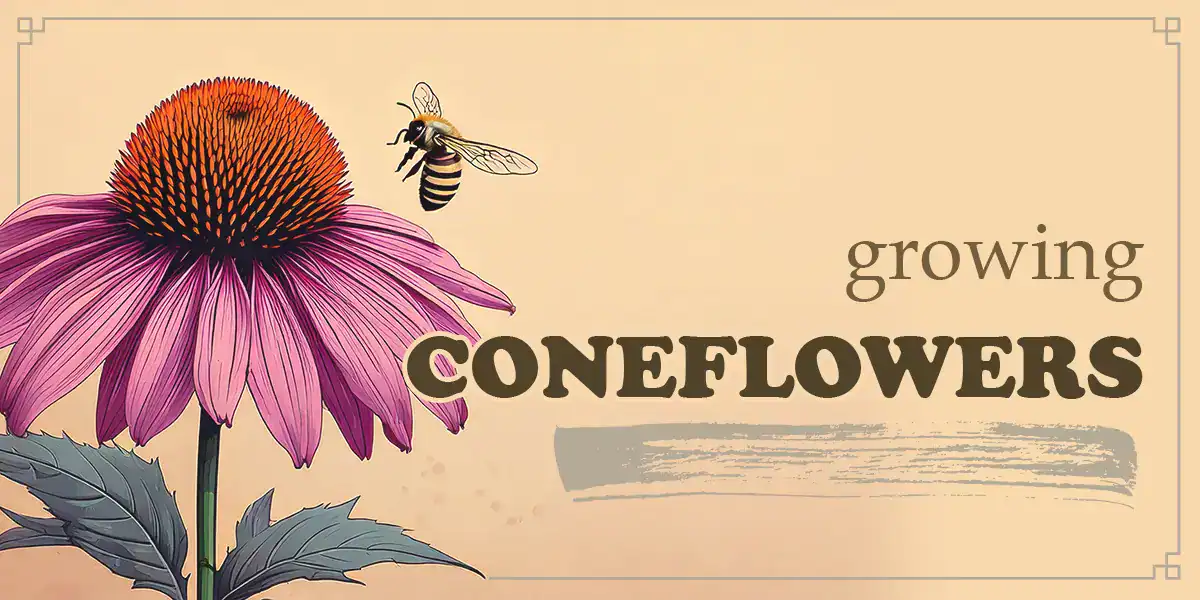“Coneflower” refers to the entire Echinacea genus, which includes about nine species. The most popular and studied one is Echinacea purpurea, with its striking purple blooms.
Native American tribes used Echinacea for centuries to treat wounds, toothaches, sore throats, infections, and snake bites — long before modern medicine noticed.
Beyond their medicinal value and unusual beauty, coneflowers are irresistible to pollinators. Once established, they’re resilient to drought and poor soil.
Are Coneflowers Annual or Perennial?
Good news for low-effort gardeners — coneflowers are perennials. They return year after year, getting bigger and better with age.
Their long blooming season ensures continuous color when many other plants have faded. Deadheading (removing spent blooms) encourages even longer flowering periods.
Coneflowers’ sturdy stems and dense foliage protect insects and small animals from predators and harsh weather. Their prominent, nectar-rich centers are a long-lasting food source for bees, butterflies, and other insects, while their seeds nourish birds like finches after the blooming season.
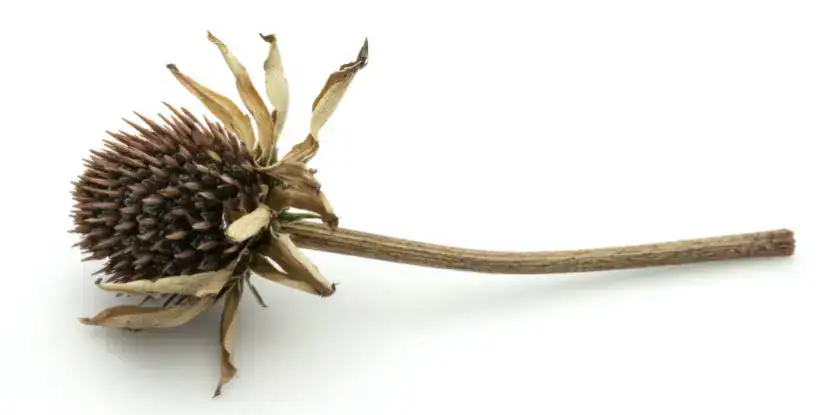
The dry seed head of a coneflower.
Mature Size
Most coneflower species and varieties fall within this range:
- Height: 2 to 4 feet tall (some dwarf or compact varieties are shorter, around 12–18 inches, while taller types can exceed 4 feet).
- Spread: 1.5 to 2.5 feet wide.
- Growth Habit: Upright with a clumping form; they slowly expand via rhizomes but are not aggressive.
They typically reach their mature size by the second or third growing season.
Top Varieties for Southern California
Echinacea purpurea ‘Magnus’
- Classic purple blooms with a strong upright habit.
- Tolerates a wide range of soils.
- One of the most adaptable and hardy cultivars.
Echinacea’ PowWow Wild Berry’
- Compact (16–20 inches tall) and very heat-tolerant.
- Brilliant magenta blooms.
- Performs well in containers and small garden beds.
Echinacea ‘Sombrero’ Series
- Bred for hot climates — ideal for SoCal gardens.
- Includes colors like Sangrita (red), Lemon Yellow, and Baja Burgundy.
- Compact and floriferous.
Echinacea’ Cheyenne Spirit’
- A mix of colors from red to orange to cream in one seed packet.
- Hardy and tolerant of poor soils.
- Great for mass plantings and pollinator gardens.
Echinacea pallida (Pale Purple Coneflower)
- Native species with slender, reflexed petals.
- More drought-tolerant than E. purpurea.
- Excellent for wildflower-style and xeriscape gardens.
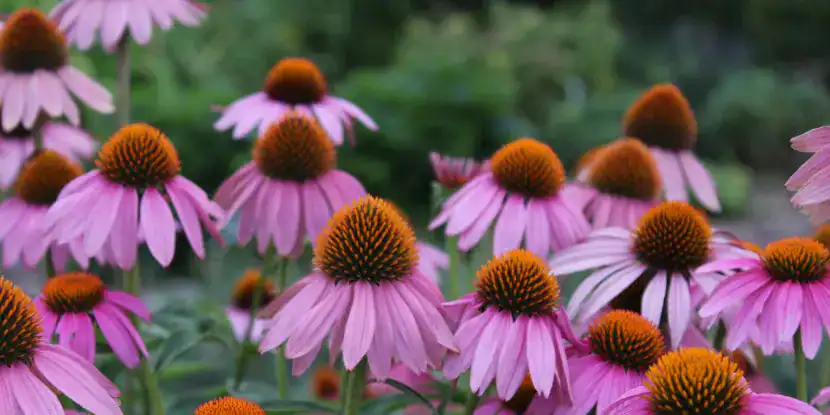
Echinacea purpurea is one of the most adaptable and hardy cultivars.
Optimal Growing Conditions
Southern California’s Mediterranean climate is ideally suited for coneflower cultivation.
Light
- Coneflowers thrive in full sun. Aim for at least 6 hours of direct sunlight daily for optimal blooms.
- While they can handle partial shade, fewer blooms and leggy growth are likely.
Temperature
- Coneflowers love the heat and are drought-tolerant once established.
- Most varieties withstand mild winter frost. A layer of mulch can protect roots from freezing.
Soil
- Well-drained soil is crucial. Avoid clay-heavy or waterlogged soil.
- Coneflowers prefer neutral to slightly acidic soil (pH 6.0–7.0).
- Adding organic compost can improve soil fertility and drainage.
Planting Coneflowers
Choose a sunny area with good soil drainage.
Planting from Seed
- Plant seeds in late fall for blooms the following year.
- Scatter seeds on top of prepared soil and tamp them down lightly.
- Keep the area moist until sprouts appear.
- When plants reach 3 inches, thin them to allow for airflow between plants.
- Transplant young seedlings into a sunny location with well-drained soil, spacing them 12–18 inches apart.
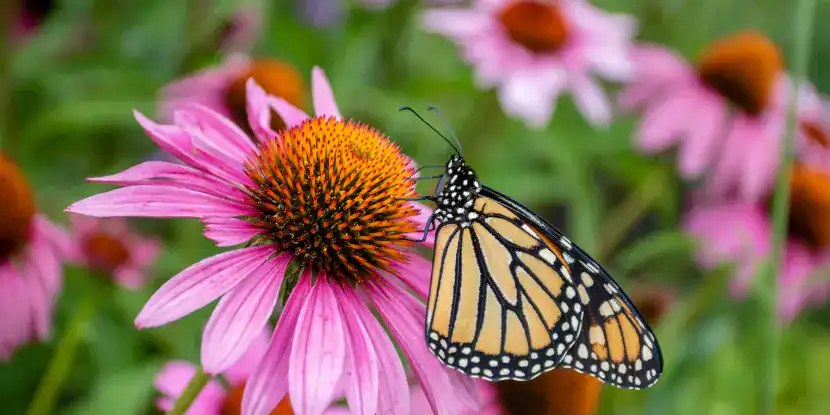
A butterfly rests on a purple coneflower.
Planting Seedlings
- Choose healthy nursery plants with sturdy stems and green leaves.
- Dig a hole twice as wide and deep as the plant’s root ball.
- Carefully remove the plant from its container and loosen compacted roots before placing it in the hole.
- Backfill the hole with soil, gently firming around the roots.
- Water thoroughly to ensure good root-to-soil contact.
- Add a layer of mulch around the base of the plant to help retain moisture and suppress weeds.
Coneflower Care
Watering
- Water newly planted coneflowers weekly until established.
- Mature plants are drought-tolerant but should be watered during prolonged dry spells.
- Avoid overwatering; soggy soil can cause root rot.
Fertilizer
- Coneflowers don’t need heavy fertilization. Overfeeding can lead to weak, leggy growth.
- Apply a balanced, slow-release fertilizer in spring for best results.
- Enrich the soil with compost annually to maintain organic matter.
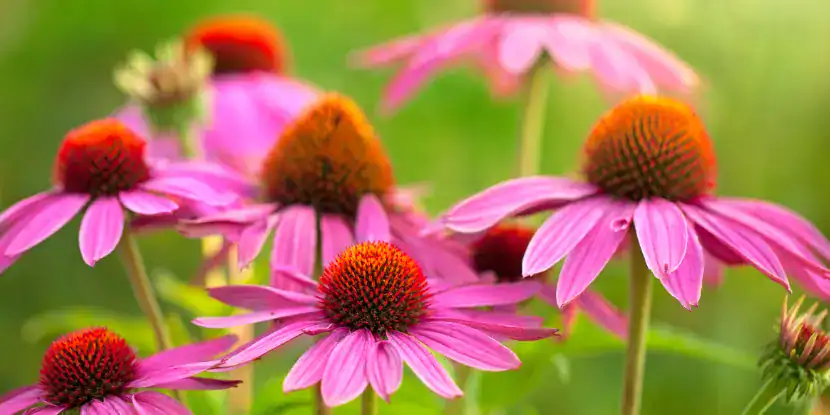
Vibrant purple coneflowers in the sun.
Dealing with Pests
- Handpick larger pests like slugs and caterpillars, use insecticidal soap for smaller insects, and introduce beneficial insects like ladybugs and lacewings to control populations naturally.
- Natural repellents include garlic spray, hot pepper spray, and diatomaceous earth.
- Avoid harsh chemical pesticides that can harm beneficial insects and pollinators.
Preventing Diseases
- Practice good sanitation in the garden by removing and disposing of diseased plants, leaves, or debris.
- Rotate crops yearly to prevent the build-up of soil-borne diseases.
- Choose disease-resistant plant varieties when possible.
- Water at the base of plants instead of overhead to avoid fungal diseases.
- Apply organic fungicides such as copper sulfate or sulfur to help control fungal diseases.
Pruning
- Encourage continuous blooms by trimming fading flowers. Allow some to remain in late fall to feed birds.
- Cut back leaves and stems to ground level during late winter to prepare for fresh spring growth.
Growing Coneflowers in Containers
- Choose a large container with adequate drainage holes.
- Use well-draining, nutrient-rich potting soil to promote healthy root development.
- Place the container in a location with at least 6 hours of daily sunlight to ensure robust blooms.
- Water regularly, but avoid over-watering. Coneflowers prefer slightly dry conditions once established.
Propagation Methods
- Divide coneflowers every 3–4 years to maintain healthy growth and encourage more blooms.
- Propagate new plants by collecting seeds from spent flowers in the fall. Dry them thoroughly before planting.
- Alternatively, you can take cuttings from mature plants and root them in soil or water to grow new coneflowers.

Classic coneflowers can be purple, pink, or white. Modern hybrids can be yellow, orange, and more.
FAQs: Growing Coneflowers
Q: Can I grow coneflowers in containers?
Yes, as long as the container has drainage holes and is large enough for root growth.
How often should I fertilize coneflowers?
Once annually in spring is sufficient for most plants.
Q: Do coneflowers spread?
Coneflowers can reseed themselves. To prevent spreading, deadhead spent flowers before they go to seed.
Q: What wildlife do coneflowers attract?
Bees, butterflies, hummingbirds, and birds are frequent visitors.
Q: Are coneflowers deer-resistant?
Generally, yes. However, ravenous deer may nibble if other food sources are scarce.
Q: How long do coneflowers live?
With proper care, coneflowers can live 3–5 years or more.
Q: Can I divide coneflowers?
Yes, divide clumps every 3–4 years in early spring to rejuvenate plants and increase your stock.
Q: Why aren’t my coneflowers blooming?
The most common causes are insufficient sunlight, overcrowding, or excessive fertilization.

